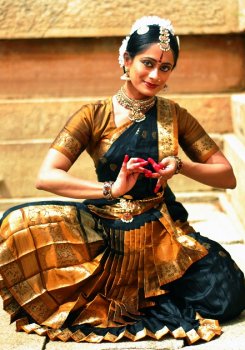
|   |

|   |
Anuradha Venkatraman’s Bharatanatyam recital - Dr. Sunil Kothari e-mail: sunilkothari1933@gmail.com May 19, 2012 It was after an interval of four years that I got an opportunity to see Anuradha Venkatraman’s recital at India International Centre, New Delhi, on 16th May 2012. Anuradha had joined School of Arts and Aesthetics at Jawaharlal Nehru University (JNU) ten years ago and obtained an MA in Arts and Aesthetics with dance as a special subject. That was when I first saw her as I was teaching at JNU. As a disciple of Saroja Vaidyanathan, she had spent many years learning from her, mastering the technique. After marriage, she moved to Bangalore where she continues performing and also teaching.  Like her young contemporaries, she has been on the scene for more than fifteen years, participating in major dance festivals like Khajuraho, Shruti Mandal, Jaipur, and Natyanjali and has performed abroad in many countries. She has stage presence and gives an impression of confidence in whatever she performs. A fine figure with a mobile visage which registers expressions effortlessly, Anuradha performs gracefully, engaging attention of the spectators. Beginning with Shiva stuti in Gambhira Natai raga, Anuradha started with a static nritta pose of Lord Shiva and after a few arresting movements, performed without sahitya through nritta, extolling the epithets vadyanrityapriya, which was rendered earlier, interweaving playing upon instruments like veena, mridangam, flute, damaru, and created visuals to appropriate accompaniment of mridangam. This approach was interesting in place of one to one hastabhinaya to the text recited. It added sparkle to the number. The sculpturesque poses of Lord Shiva were captured with finesse. It was Khamas varnam in Adi tala in praise of Pandya princess born out of fire, with three breasts, trained in martial arts, archery, sword fighting, worthy of a prince. She encounters Lord Shiva and her third breast falls; she turns into a charming princess, is married to Sundareswara (Shiva) and the refrain ‘Maate Malayadhwaja’ with other epithets like Chamundeswari, giving her scope for sancharis, improvisations, the goddess in her fierce form, annihilating the demons and holding the spear - Anuradha was in her element. She struck poses along with the mnemonic syllables on mridangam and spirited nattuvangam by Swapna Sheshadri, mridangam by R Kesavan, who had composed the jathis, vocal by K Venkateswaran and flute by Rajat Prasanna. The mood was built up artistically. Anuradha’s nritta passages were interestingly choreographed. Instead of frontal and horizontal presentation, she moved in circular fashion covering the stage, which looked novel. The teermanams were executed with precision which showed her complete command over tala and rhythm. Working with mridangist R Kesavan, Anuradha seemed to have explored space and also tala variations. Within a time cycle there were attempts at faster tempo, reverting back to basic tala, proving an acid test for a dancer. In short, it was a joyous exposition. Since the varnam gave scope for martial stances, sculptural postures, the exploration added to the narrative an element of the sahitya and looked a welcome addition. Of course the araimandi, the leg extensions, the diagonals and geometrical patterns were perfect which Anuradha performed with élan and grace. It was in Kshetragna’s Telugu padam 'Yatu vante vadi vade O yamma?' that Anuradha displayed her command over abhinaya. Beginning with the anupallavi ‘kuteel kuntala’ describing the curly hair of dark Lord Krishna, nayika playing on the river bank, drawing patterns on sand, finding a peacock feather falling, capturing it and hiding it in pallu of her saree, she tells her sakhi: “I do not know who he is - that charming chap with peacock feathers in his crown; when he plays flute the animals stand still listening to the divine music. Well, I have heard stories making rounds of his adventures. Sure he is a flirt; dressing like a noble man, he walks with heroic grace, seduces women - I have heard so – no, I do not know who he is. Have heard stories, but I do not know. I would not care for such a fellow, who like a bee on lotuses moves from one maiden to another. I would not let him even come near me!” Anuradha wore expressions of shringara, coyness, fake anger, innocence, with eyes moving from one corner to another. Without uttering a word, she spoke eloquently through her eyes creating an illusion of her sakhi standing near her and conversing with her. It was evident that the nayika was madly in love with Venugopala, and even after a bravado talk to her sakhi that if he comes she will lock the door on his face and ignore him, when the sakhi leaves her, the nayika opens the door and looks for Krishna - alas he is not around. I am familiar with the padam having seen it when Kalanidhi Narayanan taught it to many dancers. I was told that now Bragha Bessell is teaching it. I checked up with Anuradha about the improvisations she has used in the delineation of the bhavas, in particular about picking up a peacock feather, caressing it and thinking of Krishna. She said it was her own imagination and improvisation. That augurs well for a dancer with enough exposure and her study of literature needs to invest the abhinaya numbers with such delicate nuances. Anuradha performed two more numbers Nandanar’s story and a Tillana. I missed the numbers but what I saw of her performance remains etched in my memory and I would like to see her more often. Her orchestra was in perfect sync with her and it was obvious they all had a good rapport. Dr. Sunil Kothari is dance historian, scholar, author and a renowned dance critic. He is Vice President of World Dance Alliance Asia Pacific India chapter, based in New Delhi. He is a regular contributor to www.narthaki.com, the roving critic for monthly magazine Sruti and is a contributing editor of Nartanam for the past 11 years. |